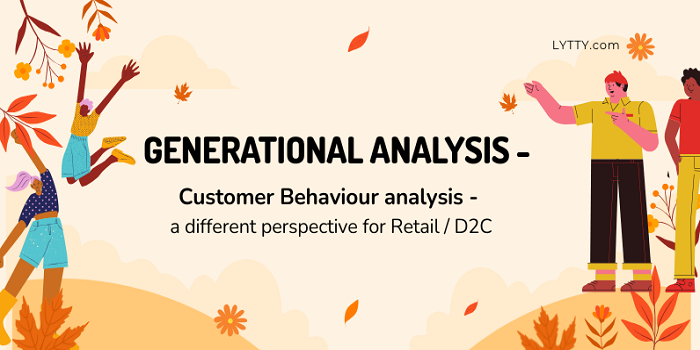
Published: Jun 20,2025

Knowing who will buy, how they will buy, why they are buying, and when they will buy — these questions all revolve around one crucial factor: your customer.
Retail businesses today are compelled to go beyond surface-level data and develop a deep understanding of consumer buying patterns and behavioral psychology. In an age of information overload and shrinking attention spans, personalized engagement is no longer a luxury — it's a necessity.
Let’s take a look back, say 15 to 20 years ago. Shoppers typically visited physical stores with their family or friends. The decision-making process was straightforward — driven by basic needs, brand loyalty, or advertisements on TV, radio, or newspapers. Retailers relied on in-store feedback, manual surveys, and creative marketing campaigns to capture attention. Consumer journeys were linear and predictable.
But today? That’s a different story.
Consumers are moving towards digitally assisted buying. Whether it's a chatbot on a website, a Google review, or an Instagram Reel by an influencer — the path to purchase has become non-linear, impulsive, and tech-assisted.
This complexity presents both challenges and opportunities for retailers.
While there are several proven frameworks to understand customer behaviour — such as demographic profiling, psychographics, and purchase funnels — one often underestimated yet powerful filter is the Generational Map. Why? Because each generation is shaped by the technology, values, and culture they grew up with — directly influencing how they discover, evaluate, and buy products today.
A key step in decoding buying behaviour is identifying the generation your customers belong to. Each generation has distinct attitudes, buying preferences, and influences. Here’s a breakdown:
Born between: 1965 – 1980
Born between: 1981 – 1996
Born between: 1997 – 2012
Born from: 2013 onwards
|
Behavioural Trait |
Generation X (1965–1980) |
Millennials (1981–1996) |
Gen Z |
Gen Alpha (2013– ) |
|---|---|---|---|---|
|
What will they do when they need to buy something? |
Research online and visit trusted stores. Prefer comparing before buying. |
Search online, check reviews, consult friends. |
Immediately check social media or influencers, browse marketplaces. |
Ask parents or explore via YouTube, voice search, or apps. |
|
How do they choose between different products? |
Based on quality, brand reputation, and expert advice. |
Look for balance: features, price, and peer reviews. |
Influenced by trends, peer validation, and influencer opinions. |
Highly visual appeal, gamified interfaces, and family opinions. |
|
How long to take a purchase decision? |
Days to weeks, depending on value. |
Hours to days. |
Minutes to hours (fast and impulsive). |
Very quick; highly influenced by emotional triggers. |
|
Value for social acceptance? |
Moderate – prefer utility and value. |
High – seek products that reflect personality. |
Very high – social image drives choices. |
Extremely high – brand becomes part of identity early on. |
|
Willingness to pay a premium for a liked product? |
Only if convinced about durability and brand. |
Will pay extra for ethical, aesthetic, or exclusive features. |
Frequently pay premium for trending or unique products. |
High, though driven by parents – prefers “cool” over “cheap.” |
|
Reaction to issues after purchase |
Expect responsive customer service; vocal if disappointed. |
Raise tickets or post detailed reviews. |
Will express on social media and shift loyalty quickly. |
May abandon or avoid silently; parents handle complaints. |
|
Reaction to positive experiences |
May stay loyal, give referrals offline. |
Leave reviews, recommend to friends. |
Share on social media, create content (e.g., Reels, stories). |
Eager to show off via digital platforms or to peers. |
|
Social expression after buying? |
Limited – word-of-mouth or personal networks. |
Share experiences online if exceptional. |
Highly expressive – posts, reviews, unboxings. |
Visual-heavy sharing — short videos, stickers, in-app stories. |
What This Means for Retailers
Understanding generational buying behavior isn’t just a marketing tactic — it’s a strategic business lever. When retailers embrace the distinct traits of each generation, they gain the ability to predict trends, personalize experiences, and optimize engagement with surgical precision.
Here’s how this insight can transform your retail strategy:
Retailers who fail to adapt risk falling behind. On the other hand, those who embrace behavioral insights and personalize every touchpoint — from discovery to loyalty — will thrive. In the new world of commerce, understanding “why they buy” is more important than just knowing “what they bought.”
Behavioral data, emotional insights, generational preferences — these are the new goldmines for retail growth.
If you're in retail and want to build lasting customer relationships, start by asking:
Once you know the answers, tailor your technology, team, and touchpoints to speak their language.
In today’s competitive landscape, retailers can no longer rely on intuition or generic campaigns. The real growth lies in understanding the psychology and patterns behind each customer's journey — from the moment they think of buying to how they feel after purchasing.
This is exactly where LYTTY makes a difference.
LYTTY is a Customer Loyalty & Engagement platformbuilt specifically for retail businesses. It gives you deep insights into your customer segments — Gen X, Millennials, Gen Z, or Alpha — and helps you tailor communication, offers, and loyalty rewards to match their unique buying behavior.
With LYTTY, you can:
So, whether you’re selling furniture, fashion, cosmetics, or food — LYTTY helps you stay relevant, personalized, and profitable in the age of hyper-individualized retail.
If you’re ready to turn customer behavior into business growth, it’s time to explore LYTTY.
